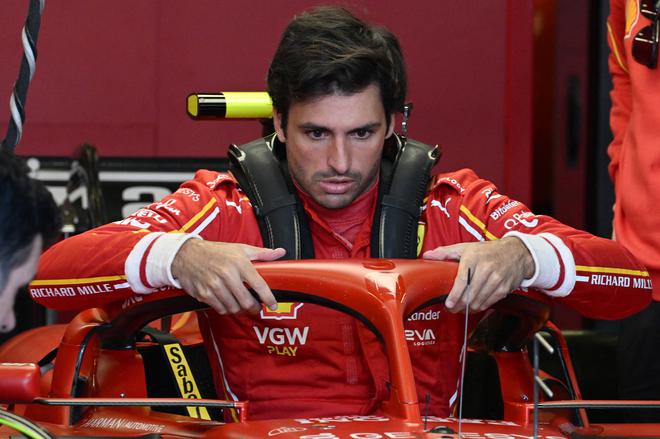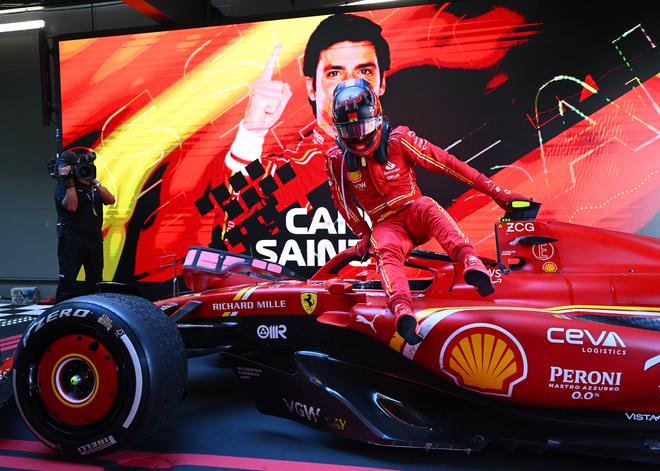When Carlos Sainz was in hospital after having his appendix removed, the most natural thing for him — if he were the average human being — would have been to wallow in self-pity.
The emergency surgery meant he would miss the Saudi Arabian Grand Prix — in the cut-throat world of Formula One, you never give another driver an even break, and Sainz was being forced to do just that.
Significant displacement
This turn of events, moreover, had followed a more significant displacement: the Spaniard had learnt before the season that seven-time world champion Lewis Hamilton would replace him at Ferrari in 2025.
Out of work at the end of the year and out of commission for at least one Grand Prix, Sainz watched British teenager Oliver Bearman step into his car in Jeddah and drive it to seventh place on an extraordinary F1 debut. Most people, confronted by an equivalent set of circumstances, would have sunk back into their beds in a gloomy, woe-is-me mood.
Sainz, however, got to work. “As soon as I got my appendix removed, I went on the internet and started talking with professionals and said, ‘OK, what helps to speed up recovery?’,” he told reporters.
“I started doing all the sort of things that you can do to speed up recovery, the wounds, the scar tissue, what you can help to be faster on that, talking to other athletes, talking to other doctors in Spain, internationally. And then I put together a plan with my team.
“The reason why athletes recover faster is because you can dedicate 24 hours per day for seven days to recovery. And that’s exactly what I did.”

Sainz had twice daily hour-long sessions in a hyperbaric chamber, breathing pure oxygen at higher pressure, and used an electromagnetic INDIBA machine for tissue repair. He programmed his time spent in bed, walking and eating “the kind of food that you have to recover.”
Stunning recovery
Two weeks after surgery, Sainz was back in his Ferrari, ready for the Australian Grand Prix.
“Nine days ago, when I was about to catch the flight to come to Australia, I was still in bed. I could barely use my abdominal [muscles] to move. And I was like, this is not going to happen,” he said. “But I took the flight, and suddenly when I landed in Australia, the feeling was a lot better.
“And every 24 hours, I was making a lot more progress than the first seven days, which is actually what all the doctors and professional people told me. Don’t worry, because the second week, every day is going to improve a lot more than the first week.”
Although he was improving, Sainz knew that driving a Formula 1 car — a physically punishing experience at the best of times — would be even more challenging after an appendectomy. So he consulted Williams driver Alex Albon, who had had his appendix removed in 2022.
“I feel like it’s exactly what Alex told me,” Sainz said. “With the g-force and everything, on the inside, it just feels like everything is moving more than normal and you need some confidence to brace the core and the body as you’re used to doing, but you get used to it.
“There is no pain, nothing to worry about. It’s just a weird feeling that you have to get used to. Especially on this circuit, we’re pulling five to six Gs in some of the braking zones and corners.”
If he felt stiff and tired by the end of the race at Albert Park, the result exceeded all expectations. Sainz handled the “weird feeling” to capitalise on a mechanical failure for three-time world champion Max Verstappen — the back of his Red Bull began spewing smoke, with fire following, forcing Verstappen’s retirement — and win the Australian Grand Prix.
Resilience that runs deep
The Spaniard was the first driver since Austrian Gerhard Berger in 1997 to win his first race back from a medical absence — perhaps not surprising when you consider that resilience runs in the Sainz family. After all, his father, Carlos Sainz Sr., won the gruelling Dakar Rally for a fourth time earlier this year, becoming the oldest winner of the race at 61.
The younger Sainz, with his victory in Melbourne, remains the only driver outside Red Bull to triumph since 2022 — some feat for a man still without a seat for 2025. His last win came in Singapore last year, when he showcased his race-craft and lateral thinking. Leading the race on a track with few overtaking opportunities, he deliberately lapped slower than he might have done, keeping the pack within range and too close to make a strategic pit-stop work.
After a safety car came out, Sainz saw another way of getting the win without going faster. He slowed down and cleverly kept second-placed Lando Norris within DRS range, helping the Englishman prevent the hard-chasing George Russell and Hamilton from challenging for No. 1.
These two wins — Singapore 2023 and Melbourne 2024, in the midst of Red Bull dominance — prove that Sainz can make the most of the smallest opportunity. His ability to stay calm in the heat of battle, analytically plot a route to victory when a sliver of a chance opens up, and then execute the race without making an error has earned him the nickname ‘Smooth Operator’.
The calm, clinical approach is married to a scrappy, aggressive driving style. Unlike Verstappen and Charles Leclerc, he enjoys a less skittish car. “I prefer a car that understeers than a car that oversteers,” he once said. “Why? because my driving is really aggressive. When I am out on track, I know everyone calls me ‘Smooth Operator’ but I can make a car rotate… I turn the car myself with the steering wheel and the pedals.”

Underrated and respected
With just three career race wins, Sainz may not have the numbers some others on the grid have — but that is also a function of him rarely having cars that could contend for victory. Sainz does, however, have the respect of his peers and predecessors. Regarded as the most underrated driver in the sport, he is a man team principals will be keeping a close eye on.
With vacancies, or potential vacancies, in top teams such as Mercedes and Red Bull for next season, Sainz should have attractive options to choose from. He is giving himself “enough time and enough information” to make a decision on “probably the most important three or four years of my career”, but his focus for the moment is more immediate.
“I am still without a job for next year,” Sainz said after his victory in Melbourne. “Everyone more or less knows what I’m capable of doing. I don’t race to prove to team principals my value. I race for myself. That’s the mentality and approach I have and will continue to.”
If Ferrari’s early promise holds, Sainz, who has already ended two Red Bull streaks, will back himself to pull off something truly breathtaking in his final season in red.







